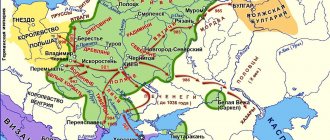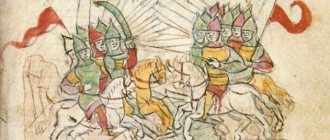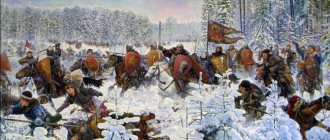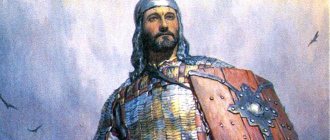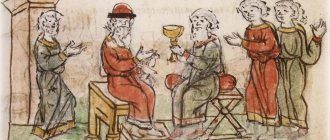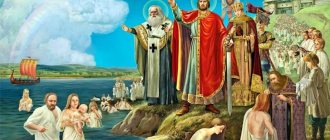The children of the great Vladimir Svyatoslavich are very numerous, which is not surprising - the Grand Duke was very loving both before and after the adoption of Christianity. In total, we can more or less reliably talk about 15 of his children from different wives. Most of them faced a sad fate - after the death of Vladimir the Saint, his sons began to fight each other for the right to primacy in governing the state, as a result of which many were killed.
The battle between the troops of the brothers Yaroslav and Svyatopolk near Lyubech (1016). Radziwill Chronicle.
short biography
Vladimir Svyatoslavich Portrait from the “Tsar's Titular Book” of the 17th century Detailed biography
Prince Vladimir I the Great is the son of Prince Svyatoslav Igorevich and Malusha, the slave-concubine of Princess Olga, under whom the Baptism of Russia took place. Also known by the nicknames “Saint”, “Baptist”, and is associated with the folklore character “Vladimir the Red Sun”. He was appointed prince of Novgorod by his father in 970. In 978 or 980 he seized the Kiev throne after the murder of his brother Yaropolk in an internecine war.
In 988, he took the Byzantine city of Chersonesus and demanded his sister from the Byzantine emperor to be his wife. As a condition of marriage, he accepted Christianity according to the Greek rite, after which he made it the state religion of Kievan Rus.
During his reign he had a large number of children from different wives, which predetermined the second civil strife in Rus' after his death in 1015.
Baptism of Rus'
Tradition says that in 983, after a successful military campaign, Vladimir decided to make a human sacrifice to the pagan gods. It was decided to choose her by lot, which fell on the young man John. The young man's father Theodore, being a Christian, did not want to give up his son and began to condemn pagan idols and glorify the Christian faith. Then an angry crowd of pagans killed Theodore and his son. These were the first Christian martyrs in Rus'; the memory of the holy martyrs Theodore and his son John is celebrated on July 25 (12 according to the old style).
As the chronicles tell about the “choice of faiths” (“test of faiths”), embassies from different nations came to the prince in Kyiv in 986, calling on him to convert to their faith. First, the Volga Bulgarians of the Muslim faith came and praised Mohammed, then foreigners from Rome preached the Latin faith from the pope, and the Khazar Jews preached Judaism. The last to arrive, according to the chronicles, was a preacher sent from Byzantium. He began to tell Vladimir about Orthodoxy. To understand whose faith is better, Prince Vladimir sent nine envoys. The ambassadors visited the countries from which the preachers came. Returning to Kyiv, they told the prince everything they had seen and praised the Greek Orthodox faith. However, Vladimir did not immediately accept Christianity.
In 988, he captured Korsun (now the territory of the city of Sevastopol) and demanded Anna, the sister of the Byzantine emperors Vasily II and Constantine VIII, as his wife, threatening otherwise to go to Constantinople. The emperors agreed, demanding in turn that the prince be baptized so that his sister could marry a fellow believer. Having received Vladimir's consent, the brothers sent Anna to Korsun. There, in Korsun, Vladimir and his warriors were baptized by the bishop of Korsun, after which they performed the wedding ceremony. At baptism, Vladimir took the name Vasily, in honor of the ruling Byzantine emperor Vasily II.
Returning to Kyiv, accompanied by Korsun and Greek priests, Vladimir baptized his sons from his previous wives in a spring known in Kyiv as Khreshchatyk. Following them, many boyars were baptized.
Mass baptism of Kiev residents took place at the confluence of the Pochayna River into the Dnieper. The chronicles read: “The very next day, Vladimir went out with the Tsaritsyn and Korsuin priests to the Dnieper, and countless people gathered there. They entered the water and stood there, some up to their necks, others up to their chests, small children near the shore up to their chests, some holding babies, and adults wandering around, while the priests performed prayers, standing still...” This most important event took place, according to the chronicle chronology, in 988.
Following Kiev, Christianity gradually came to other cities of Kievan Rus: Chernigov, Volyn, Polotsk, Turov, where dioceses were created. The baptism of Rus' as a whole dragged on for several centuries - in 1024 Yaroslav the Wise suppressed the uprising of the Magi in the Vladimir-Suzdal land (a similar uprising was repeated in 1071; at the same time in Novgorod the Magi confronted Prince Gleb), Rostov was baptized only at the end of the 11th century, and in Murom, pagan resistance to the new faith continued until the 12th century.
Reign of Prince Vladimir I Svyatoslavich 980-1015
Interactive timeline
The beginning of the reign - the civil strife of the Svyatoslavichs
The beginning of the first civil strife in Rus', which arose 5 years after the death of Prince Svyatoslav Igorevich, was the murder of the son of the Kyiv governor Sveneld by Oleg Svyatoslavich during a hunt. Sveneld took advantage of his influence on the young Prince Yaropolk and decided to take revenge on his son’s murderer. Having learned about Oleg’s death during a clash with Yaropolk’s troops near the city of Ovruch, Vladimir fled “overseas” and returned the next year with a mercenary army of Varangians. Having found a traitor among Yaropolk’s advisers in the person of Voivode Blud, Vladimir cunningly lured his brother out of the besieged Roden fortress for negotiations and ordered his death, after which he occupied Kyiv and began to rule autocratically.
According to the chronicle, Vladimir reigned in Kyiv in 980. According to the earliest Life of Vladimir by the monk Jacob [1] “Memory and praise to Prince Vladimir”, 2nd half of the 11th century, this happened on June 11, 978.
Murder of Yaropolk. Hood. B. A. Chorikov. More about the feud
Brief description of domestic policy
After winning the civil strife and capturing Kyiv, Vladimir suppressed the uprisings of the Vyatichi and Radimichi tribes and tried to centralize the princely power. The “pagan” reform could not solve this issue, and in 988 the prince carried out a radical break - he carried out the baptism of Rus'. Greek culture began to penetrate the life of the Eastern Slavs - temples were built, schools were opened, and coinage began for the first time. Those dissatisfied with the prince's policies migrate in the northern and northeastern directions.
The accumulated contradictions did not allow the prince to carry out the last of the planned reforms - instead of inheriting by seniority, Vladimir wanted to appoint one of his favorite younger sons as the ruler of Kyiv, but he died and the older heirs started civil strife.
General scheme of the domestic policy of Vladimir I Svyatoslavich More about domestic policy
What Vladimir Red Sun did - in brief
Grand Duke Vladimir Svyatoslavovich ruled Kiev from 978 to 1015. During this time he did a lot. Thanks to this prince, his competent domestic policy and external political and military actions
- the borders of the state expanded and strengthened;
- agreements were reached with the Byzantine, Polish, Czech, and Hungarian rulers;
- monetary reform was carried out.
But the main thing is that after Christian baptism, the civilizational isolation of Rus' was overcome, and a new round of its history began.
Historiography.
- Tatishchev V.N. Russian History, 1768.
- Karamzin N. M. History of the Russian State.
- Rybakov B. A. Ancient Rus'. Pancakes. Chronicles, 1963.
- Jackson T.N. Icelandic royal sagas as a source on the history of Ancient Rus' and its neighbors. X-XIII centuries, 1991.
- Mikhailovich D. M. The saga of Rurik and his descendants, 1995.
- Danilevsky I. N. Ancient Rus' through the eyes of contemporaries and descendants (IX-XII centuries), 1998.
- Pchelov E.V. History of the Rurikovich dynasty, 2002.
- Semenenko-Basin I. V. Vladimir Kyiv, 2002.
- Sverdlov M. B. Pre-Mongol Rus': Prince and princely power in Rus' VI - the first third of the XIII century, 2003.
- Fomin V.V. Varangians and Varangian Rus', 2005.
- Petrukhin V. Ya. Rus' in the 9th-10th centuries. From the calling of the Varangians to the choice of faith, 2014.
Briefly about the essence and directions of foreign policy
The goal of the foreign policy of Vladimir I Svyatoslavich was to expand the influence of Kiev in all directions: conflicts with Poland over border lands and tribes, campaigns against Volga Bulgaria and the Khazars, the fight against the Pechenegs and relations with Byzantium - the actions of the Grand Duke were directed to the borders of the state from its center, Kiev. Unlike his father, Svyatoslav Igorevich, Prince Vladimir more often used diplomacy and, when carrying out incursions into foreign lands, preferred not to send troops deep into enemy territory, as a result - the results of his foreign policy actions were more stable than those of his predecessor. In recent years, the new Polish prince Boleslav I tried to fight with Vladimir, but soon peace was concluded, supported by a dynastic marriage between the son of the Kyiv prince Svyatopolk and the daughter of Boleslav, unknown by name.
Foreign policy of Vladimir I Svyatoslavich - map with directions of campaigns More about foreign policy
Table “main events of Vladimir I’s foreign policy”
| Year/event | Result |
| 981 – Russian-Polish war | As a result of successful military operations, Vladimir captures the so-called cities. Chervonnaya Rus - Peremysh, Cherven, etc. |
| 983 - campaign against the Yatvingians | The tribe bordering Poland and Russia was defeated and was obliged to pay tribute |
| 985 - campaign against Volga Bulgaria | Together with the Torks, Vladimir defeats the Bulgar army, but on the advice of the governor Dobrynya, he decides that attempts at conquest are futile and makes peace |
| 986-987 – “Test of Faith” | After receiving ambassador-preachers from different religions, Vladimir gathered a council and, as a result, sent responsible people to the countries of ambassadors to familiarize themselves with the rituals. |
| 988 - war with Byzantium | March on the Byzantine colony of Korsun: after the successful capture of the fortress, peace was restored on the terms of the baptism of Vladimir and the marriage between him and the Byzantine princess Anna. |
| 990 – hike to Mieszko I | Vladimir defeated the troops of the Polish prince somewhere across the Vistula River, after which a profitable peace was concluded. |
| 992 – campaign against the White Croats | one of the last independent East Slavic tribes was defeated and came under the rule of Kyiv |
| 996 – Battle of the city of Vasilev | According to the chronicles, this is the only battle in which Vladimir was defeated by the Pechenegs. |
| 1006 – embassy of the Volga Bulgars | A profitable trade agreement was concluded |
| 1013 summer-autumn - Polish-Pecheneg campaign | The new Polish prince Boleslav, together with the Pechenegs, invaded Rus', but during the devastation of the territories, the allies quarreled and the Polish prince ordered the killing of the nomads |
| 1014 – Russian-Polish world | Reception of ambassadors from the Polish prince Boleslav I and the conclusion of a dynastic marriage between Svyatopolk and the Polish princess |
Last years of reign
At the final stage of his political life, the prince no longer went on campaigns himself - the command of the squad was entrusted to the governors and his beloved son Boris. In 1014, two of his sons, Svyatopolk and Yaroslav, rebelled against Vladimir: Yaroslav refused to pay the 2,000 hryvnia tax due from Novgorod, and Vladimir ordered Svyatopolk to be thrown into prison on suspicion of preparing a coup. Instead of Svyatopolk, his wife, the daughter of Boleslav I, and the Polish bishop who came with her were sent under arrest - the purpose of the previously concluded dynastic marriage was not so much to confirm peace between Russia and Poland, but to seize power from the hands of the aging Vladimir. This is quite consistent with the description of Bolaslav from the German chronicler and bishop Thietmar of Merseburg, who emphasizes the “foxy resourcefulness” of the Polish prince [2] “Chronicle of Thietmar of Merseburg.
Vladimir was going to go to war against Yaroslav, but he was already too old and could not go due to his illness. Meanwhile, news arrived from the border outposts about the approaching Pechenegs and the prince ordered his son Boris, together with the grand ducal squad, to go to intercept the nomads.
Death and aftermath
Vladimir I Svyatoslavich died on July 15, 1015, in his country residence Berestov, near Kiev. Almost immediately after the death of the prince, a second civil strife began in Rus' - his sons began to fight each other for power. First, Svyatopolk the Accursed was able to capture the Kiev table, according to the chronicle, who sent assassins to his three brothers: Boris, Gleb and Svyatoslav Drevlyansky. Then, after several years of confrontation, Yaroslav the Wise was able to expel Svyatopolk in 1019, and he himself established himself in Kyiv, but was forced to defend his power in conflicts with his nephew Vyacheslav Bryachislavich and brother Mstislav of Tmutarakan. The final peace came only in 1026.
Scheme - the second strife in Rus' Civil strife among the children of Vladimir I
Formation of a great personality
Born to a concubine, Vladimir became the third son of the Kiev Prince Svyatoslav . At that time - around 960 - Russia was a pagan state , and it could only be called a state conditionally: cities and regions were disunited and, often, refused to obey the supreme authority in Kiev. According to the canons of that period, all children of Svyatoslav had the same right of inheritance . Vladimir, the son of a slave, was subjected to ridicule from his brothers from childhood.
His grandmother, Princess Olga , and his uncle, Voivode Dobrynya . Olga's wisdom, her baptism in Byzantium and the adoption of the Christian faith, help to grow from the boy a holistic personality with leadership qualities . The military education of the senior warrior Dobrynya develops strategic thinking and the basics of combat skill in the young prince.
Results and results of the board
- As a result of the civil strife of 977-980, Vladimir killed his brother Yaropolk and came to power.
- At the beginning of his reign, he was faced with the need to suppress the uprisings of the Vyatichi and Radimichi.
- After the clash with the Volga Bulgars, peace was concluded, embassies were exchanged, and in 1000 a profitable treaty was concluded.
- A campaign was made against the Khazars, but it was not possible to gain a foothold in the lower reaches of the Volga.
- At first he tried to focus on paganism, then he converted to Christianity and baptized Rus', which caused religious conflicts.
- For the sake of concluding the first dynastic marriage between the ruling houses of Rus' and Byzantium, Vladimir made Christianity the state religion, helped the ruler of Constantinople suppress the uprising of Bardas Phocas and carried out campaigns against the Danube Bulgarians. Having joined the ranks of the Christian states, Rus' overcame civilizational isolation, Greek culture actively began to penetrate the life of the Slavs, and the Greeks no longer expected to be afraid of the pagan Rus.
- Vladimir was able to temporarily stop the onslaught of the Pechenegs by building defensive ramparts, founding fortified cities and relocating northern tribes to guard the borders.
- The beginning of coinage in Rus' dates back to the reign of Vladimir.
- The confrontation with Poland that began during Vladimir’s lifetime was successful, but after the death of the prince, the Poles took advantage of the civil strife to return part of the lands he had conquered
- He hoped to transfer the title of Grand Duke to his son Boris, bypassing the existing tradition of inheritance by seniority, which became one of the reasons for the second internecine war in Rus'.
Military campaigns
- In 991, a campaign in the Dniester lands against the White Croats.
- In 992 there was a successful war with Poland for Cherven Rus.
- In 994 - 997, Vladimir repeated the campaign against the Volga-Kama Bulgars and moved to the North Caucasus.
Vladimir pursued an active foreign policy: during his reign, he concluded many agreements with the rulers of different countries. These were: Stephen I (King of Hungary), Boleslav I the Brave (King of Poland), Boleslav II (King of the Czech Republic), Sylvester II (Pope), Basil II (Emperor of Byzantium).
The problem of Rus' remained the constant raids of the Pechenegs: in 990, 992 on Pereyaslavl, 993, in 996 the battle of Vasilevo took place, in 997 an attack on Kyiv, in 1001, in 1013 the Polish-Pecheneg invasion of Rus' took place. Memories of the Pecheneg War a century later took on epic forms (the legend of the Belgorod jelly, of Nikita Kozhemyak, etc.). For defense against the Pechenegs, a number of fortresses were built along the southern border of Kievan Rus. Along the southern and southeastern borders of what was then Rus', on the right and left sides of the Dnieper, rows of earthen trenches and outposts were built to deter attacks by nomads. According to the testimony of the Byzantine Emperor Constantine VII Porphyrogenitus, the Pechenegs roamed at a distance of one day's travel from Rus'.
In 1006 – 1007 The German missionary Bruno of Querfurt passed through Kyiv, heading to the Pechenegs to preach the Gospel. He stopped to stay with Prince Vladimir, whom he calls Lord of the Russians in a letter to Emperor Henry II. Prince Vladimir persuaded the missionary not to go to the Pechenegs, saying that with them he would not find souls to save, but rather would die a shameful death. The prince could not persuade Bruno and volunteered to accompany him and his retinue to the borders of his land, “which he fenced on all sides with a strong palisade over a very long distance due to the enemies wandering around them.” Bruno was probably talking about the Serpentine Shafts, the length of which in the Kyiv region is about 800 kilometers.
